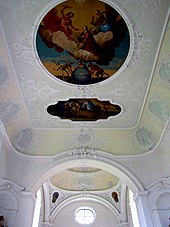Thomas Seitz (sculptor)
Thomas Seitz (born August 12, 1683 in Prem ; † November 24, 1763 in Kaufbeuren ) was a baroque sculptor and stucco maker. For around 30 years he mainly worked for the Sankt Mang monastery in Füssen , so that Adolf Layer called him the “real sculptor of St. Mang”.
The son Johann Paul Seitz (* 1714) also became a successful sculptor.
Life
Nothing is known about the life and activities of Thomas Seitz before he moved to Füssen. We don't even know when and with whom he did his sculpting apprenticeship. The Schongau sculptor Johann Pöllandt comes into question as a possible teacher due to similar stylistic features . In 1709 Seitz married Agnes Dopfer, who was also from Prem, and settled with her in Eschach (now the city of Füssen ) in 1710 . His two children Maria Barbara and Johann Paul were born there. The Füssen builder Johann Georg Fischer was the godfather of both . Later, there was even a dispute and legal disputes between Seitz and Fischer.
In 1714 Seitz moved with his family to Füssen-Faulenbach. He trained apprentices and employed journeymen. Nevertheless, he never achieved the recognition and reputation such. B. Anton Sturm . After the death of his wife in 1738, the sculptor's business also went downhill. In 1741 he had to go bankrupt. He left Füssen and finally went to his son Johann Paul Seitz in Kaufbeuren , where he died at the old age of 80.
plant
Seitz worked almost exclusively on a day-wage basis for the St. Mang monastery in Füssen for around 30 years. In most cases, the nature of his activity is not mentioned, so that only a few of his works are explicitly documented in the archives. In addition, the abbey records are sketchy.
A few works by Thomas Seitz can also be identified outside of Füssen, e.g. B. in Tyrolean Breitenwang . We are dealing here with one of the most interesting and important works by the Füssen sculptor! Because in Breitenwang, Thomas Seitz, together with the completely unknown Nikolaus Kaufmann, not only made the stucco decorations that were common at the time. The two artists also created the most remarkable dance of death in this church - in 10 stuccoed medallions in the hollow on both sides of the nave ceiling . The versatility of Thomas Seitz deserves a special mention. He worked wood, stone and stucco equally well and probably also designed individual pieces of equipment himself.
Catalog raisonné
Archival evidence is indicated by the addition (A).
- Working for St. Mang
- 1709/10 to 1720 Extensive work on the stucco work on the church and monastery
- from 1717 oak cheeks for the pews
- 1719 Leaves and cherubs' heads on the pulpit (A)
- 1720 pontifical chair (A)
- around 1720 choir stalls
- 1721 8 capitals made of Lasa marble for the tabernacle (A)
- 1723 essays for the Magdalene and Michael altars (A)
- from 1723 8 confessionals with relief cartouches
- 1724 2 dragon chandeliers and dragon chairs (A)
- 1725 figures for the two altars from 1723 (A)
- from 1726 capitals made of Lasa marble for the transept altars (A)
- 1732/33 2 altar pieces made of wood, ornaments, angels and putti for the marble transept altars
- 1734/35 decoration of the marble chapel (A)
- 1740 figures (4 large putti, Magnus with dragon?)
- 1741 Cartouche for the Benedictine altar (A)
- Working outside of St. Mang
- 1718 Mission cross in the crib church of St. Nikolaus in Füssen
- 1719 renovation work in the pilgrimage church of St. Koloman in Schwangau (A)
- 1719 Stuccoing of the Füssen nativity scene together with Paul Geyr and Johann Bader (A)
- 1719 Stuccoing of the St. Anna cemetery church in Kißlegg under the direction of the younger Johann Jakob Herkomer (A)
- around 1720 2 side altars for the Füssen nativity scene church
- around 1725 (?) Stuccoing of the parish church of St. Walburga in Weißensee
- 1725 side altars in the St. Sebastian branch church in Füssen
- around 1725 2 side altars and attachment for the choir altar in the St. Magnus Chapel in Lana -Gagers / South Tyrol (A)
- 1728 (or 1724-1726?) Stuccoing of the Resurrection Church in Breitenwang near Reutte / Tyrol (A)
- 1728-1734 Stucco decoration (?) And altar figures in the subsidiary church of St. Cross in Steingaden- Kreuzberg
- around 1730 (?) 2 figures on the choir altar of the parish church of St. Alban in Geisenried
- 1741 Carved cartouches held by putti on the two side altars of the parish church of St. Georg in Rückholz (A)
- 1745 Collaboration (?) On the two side altars of the congregational and pilgrimage church of St. Cosmas and Damian in Kaufbeuren . (These altars are archival works by Johann Paul Seitz.)
- 1757/58 collaboration (?) On the cycle of apostles in the Stötten parish church of St. Peter and Paul. (The 12 figures are also saved for Johann Paul Seitz.)
literature
- Adolf Layer: Füssen - St. Mang as the artistic center of the Lechtal Baroque and Rococo , in: Festschrift for the 1200th anniversary of St. Magnus, Füssen 1950, pp. 47-89.
- Richard Lipp: The Church of Resurrection in Breitenwang near Reutte and its artists , in: Alt Füssen 1989, pp. 203-212.
- Herbert Wittmann: Thomas Seitz (1683-1763), "The actual sculptor of St. Mang", in: Alt Füssen 2009, pp. 70 - 105, ISSN 0939-2467
Individual evidence
- ↑ Layer, Füssen - St. Mang, p. 73 and p. 75
| personal data | |
|---|---|
| SURNAME | Seitz, Thomas |
| BRIEF DESCRIPTION | German baroque sculptor and stucco maker |
| DATE OF BIRTH | August 12, 1683 |
| PLACE OF BIRTH | Prem |
| DATE OF DEATH | November 24, 1763 |
| Place of death | Kaufbeuren |





